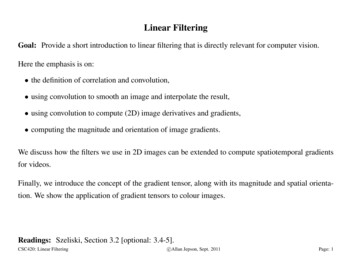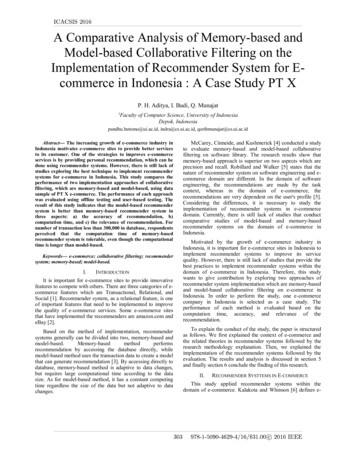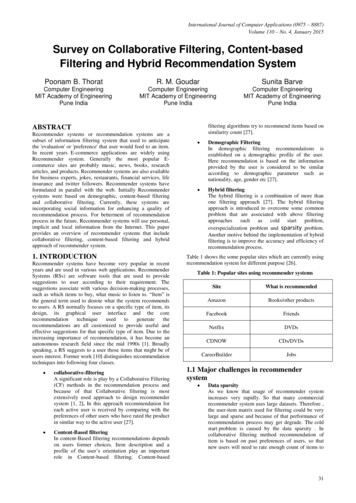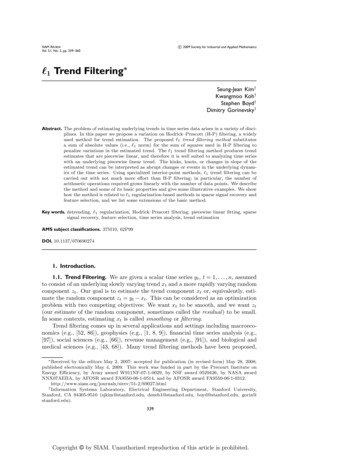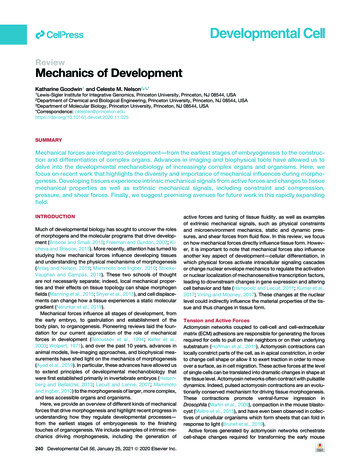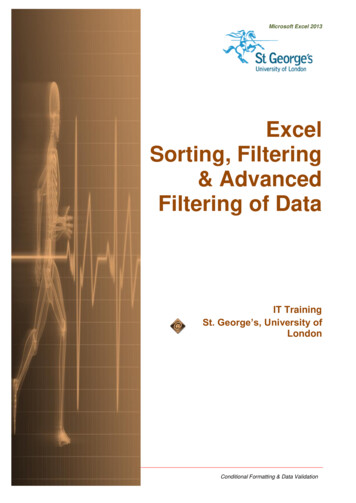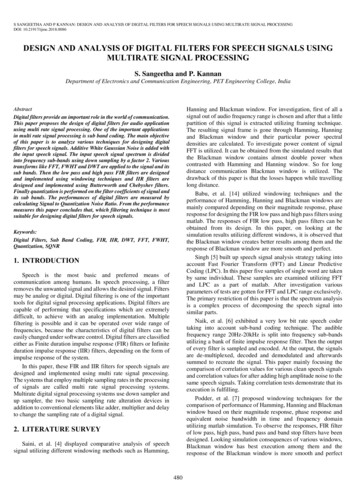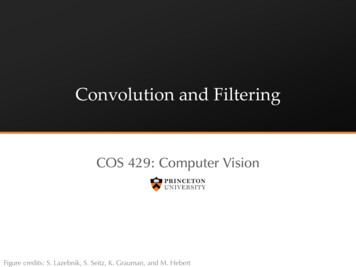
Transcription
Convolution and FilteringCOS 429: Computer VisionFigure credits: S. Lazebnik, S. Seitz, K. Grauman, and M. Hebert
Local Neighborhoods Hard to tell anything from a single pixel– Example: you see a reddish pixel. Is this the object’scolor? Illumination? Noise? The next step in order of complexity is to look atlocal neighborhood of a pixel
Linear Filters Given an image In(x,y) generate anew image Out(x,y):– For each pixel (x,y), Out(x,y) is a specific linearcombination of pixels in the neighborhood of In(x,y) This algorithm is– Linear in input values (intensities)– Shift invariant
Discrete Convolution This is the discrete analogue of convolution 𝑓 𝑥 𝑔 𝑥 𝑓 𝑡 𝑔 𝑥 𝑡 𝑑𝑑 Pattern of weights “filter kernel” Will be useful in smoothing, edge detection
Example: SmoothingOriginal: MandrillSmoothed withGaussian kernel
Gaussian Filters One-dimensional Gaussian𝐺1 𝑥 12𝜋𝜎2 Two-dimensional Gaussian𝐺2 𝑥 12𝜋𝜎2𝑥2 2𝑒 2𝜎𝑥2 𝑦2 𝑒 2𝜎2
Gaussian Filters
Gaussian Filters
Gaussian Filters Gaussians are used because:– Smooth– Decay to zero rapidly– Simple analytic formula– Central limit theorem: limit of applying (most) filtersmultiple times is some Gaussian– Separable:𝐺2 𝑥, 𝑦 𝐺1 𝑥 𝐺1 𝑦
Computing Discrete Convolutions𝑖𝑚𝑚𝑚Out 𝑥, 𝑦 𝑗𝑚𝑚𝑚 𝑖 𝑖𝑚𝑚𝑚 𝑗 𝑗𝑚𝑚𝑚𝑓 𝑖, 𝑗 In(𝑥 𝑖, 𝑦 𝑗) What happens near edges of image?– Ignore (Out is smaller than In)– Pad with zeros (edges get dark)– Replicate edge pixels– Wrap around– Reflect– Change filter
Computing Discrete Convolutions𝑖𝑚𝑚𝑚Out 𝑥, 𝑦 𝑗𝑚𝑚𝑚 𝑖 𝑖𝑚𝑚𝑚 𝑗 𝑗𝑚𝑚𝑚𝑓 𝑖, 𝑗 In(𝑥 𝑖, 𝑦 𝑗) What happens if kernel is infinite?– Truncate when filter falls off to near zero– For Gaussian, typical support between 2σ and 3σSource: K. Grauman
Computing Discrete Convolutions𝑖𝑚𝑚𝑚Out 𝑥, 𝑦 𝑗𝑚𝑚𝑚 𝑖 𝑖𝑚𝑚𝑚 𝑗 𝑗𝑚𝑚𝑚 How long does it take?𝑓 𝑖, 𝑗 In(𝑥 𝑖, 𝑦 𝑗)– If In is n n, f is m m, naive computation takes timeO(m2n2)– OK for small filter kernels, bad for large ones
Fourier Transforms Define Fourier transform of function f as𝐹 𝜔 F 𝑓 𝑥 12𝜋 𝑓 𝑥 𝑒𝑖𝜔𝜔 𝑑𝑑 F is a function of frequency – describes how muchof each frequency is contained in f Fourier transform is invertible
Fourier Transform and Convolution Fourier transform turns convolutioninto multiplication:F 𝑓 𝑥 𝑔 𝑥 F 𝑓 𝑥F 𝑔 𝑥
Fourier Transform and Convolution Useful application #1: Use frequency space tounderstand effects of filters– Example: Fourier transform of a Gaussianis a GaussianFrequency FrequencyAmplitude AmplitudeAmplitude– Thus: attenuates high frequenciesFrequency
Fourier Transform and Convolution Useful application #2: Efficient computation– Fast Fourier Transform (FFT) takes timeO(n log n)– Thus, convolution can be performed in timeO(n log n m log m)– Greatest efficiency gains for large filters (m n)
Alternative: Median Filtering A median filter operates over a window by selectingthe median intensity in the windowCredit: K. Grauman
Median FilterSalt-and-pepper noiseMedian filteredCredit: M. Hebert
Gaussian vs. Median filtering3x3GaussianMedian5x57x7
Edge DetectionWinter in Kraków photographed by Marcin Ryczek
Origin of Edges Edges are caused by a variety of factors:surface normal discontinuitydepth discontinuitysurface color discontinuityillumination discontinuityCredit: Steve Seitz
Edge Detection Intuitively, much of semanticand shape information isavailable in the edges Ideal: artist’s line drawing(but artist is also usingobject-level knowledge) But what, mathematically,is an edge?Credit: D. Lowe
What is an Edge?Edge easy to find
What is an Edge?Where is edge? Single pixel wide or multiple pixels?
What is an Edge?Noise: have to distinguish noise from actual edge
What is an Edge?Is this one edge or two?
What is an Edge?Texture discontinuity
Formalizing Edge Detection Look for strong step edges𝑑𝑑 𝜏𝑑𝑑 One pixel wide: look for maxima in dI / dx Noise rejection: smooth (with a Gaussian)over a neighborhood of size σ
Canny Edge Detector Smooth Find derivative Find maxima Threshold
Canny Edge Detector First, smooth with a Gaussian of some width σ
Canny Edge Detector Next, find “derivative” What is derivative in 2D? Gradient: 𝑓 𝑥, 𝑦 ,
Canny Edge Detector Useful fact #1: differentiation“commutes” with convolution𝑑𝑑𝑑𝑑𝑑 𝑔 𝑓 𝑔 𝑓 𝑑𝑑𝑑𝑑𝑑𝑑 Useful fact #2: Gaussian isseparable:𝐺2 𝑥, 𝑦 𝐺1 𝑥 𝐺1 𝑦
Canny Edge Detector Thus, combine first two stages of Canny: 𝑓 𝑥, 𝑦 𝐺2 𝑥, 𝑦 𝑓 𝑥, 𝑦 𝐺′1 𝑥 𝐺1 𝑦𝑓 𝑥, 𝑦 𝐺1 𝑥 𝐺′1 𝑦𝑓 𝑥, 𝑦 𝐺′1 𝑥 𝐺1 𝑦𝑓 𝑥, 𝑦 𝐺1 𝑥 𝐺′1 𝑦
Canny Edge DetectorOriginal ImageSmoothed Gradient Magnitude
Canny Edge Detector Nonmaximum suppression– Eliminate all but local maxima in gradient magnitude(sqrt of sum of squares of x and y components)– At each pixel p look along direction of gradient:if either neighbor is bigger, set p to zero– In practice, quantize direction tohorizontal, vertical, and two diagonals– Result: “thinned edge image”
Canny Edge Detector Final stage: thresholding Simplest: use a single threshold Better: use two thresholds– Find chains of touching edge pixels, all τ low– Each chain must contain at least one pixel τ high– Helps eliminate dropouts in chains, without being toosusceptible to noise– “Thresholding with hysteresis”
Canny Edge DetectorOriginal ImageEdges
Faster Edge Detectors Can build simpler, faster edge detector by omittingsome steps:– No nonmaximum suppression– No hysteresis in thresholding– Simpler filters (approx. to gradient of Gaussian) Sobel: Roberts:1 02 01 0100 1 1 2 1011200 1 2 1010 1
Second-Derivative-Based Edge Detectors To find local maxima in derivative, look for zeros insecond derivative Analogue in 2D: Laplacian2𝑓2𝑓 2𝑓 𝑥, 𝑦 2 2 Marr-Hildreth edge detector
LOG As before, combine Laplacian with Gaussiansmoothing: Laplacian of Gaussian (LOG)
LOG As before, combine Laplacian with Gaussiansmoothing: Laplacian of Gaussian (LOG)
LOG vs. DOG Laplacian of Gaussian sometimes approximated byDifference of Gaussians 2𝐺1(𝑥, 𝜎)2 𝐺1 𝑥, 𝜎 2 𝐺1 𝑥, 𝜎/ 2
Problems with Laplacian Edge Detectors Distinguishing local minimum vs. maximum Symmetric – poor performance near corners Sensitive to noise– Higher-order derivatives greater noise sensitivity– Combines information along edge, not just perpendicular
Image gradients vs. meaningful contours Berkeley segmentation jects/CS/vision/grouping/segbench/imagehuman segmentationgradient magnitude
Data-Driven Edge DetectionInput imagesGround truthTraining dataOutputP. Dollar and L. Zitnick, Structured forests for fast edge detection, ICCV 2013
Alternative: Median Filtering A median filter operates over a window by selecting the median intensity in the window . Credit: K. Grauman . Median Filter . Salt-and-pepper noise . Median filtered . Credit: M. Hebert . Gaussian vs. Median filtering . 3x3 . 5x5 7x7 Gaussian . Median . Edge Detection .

